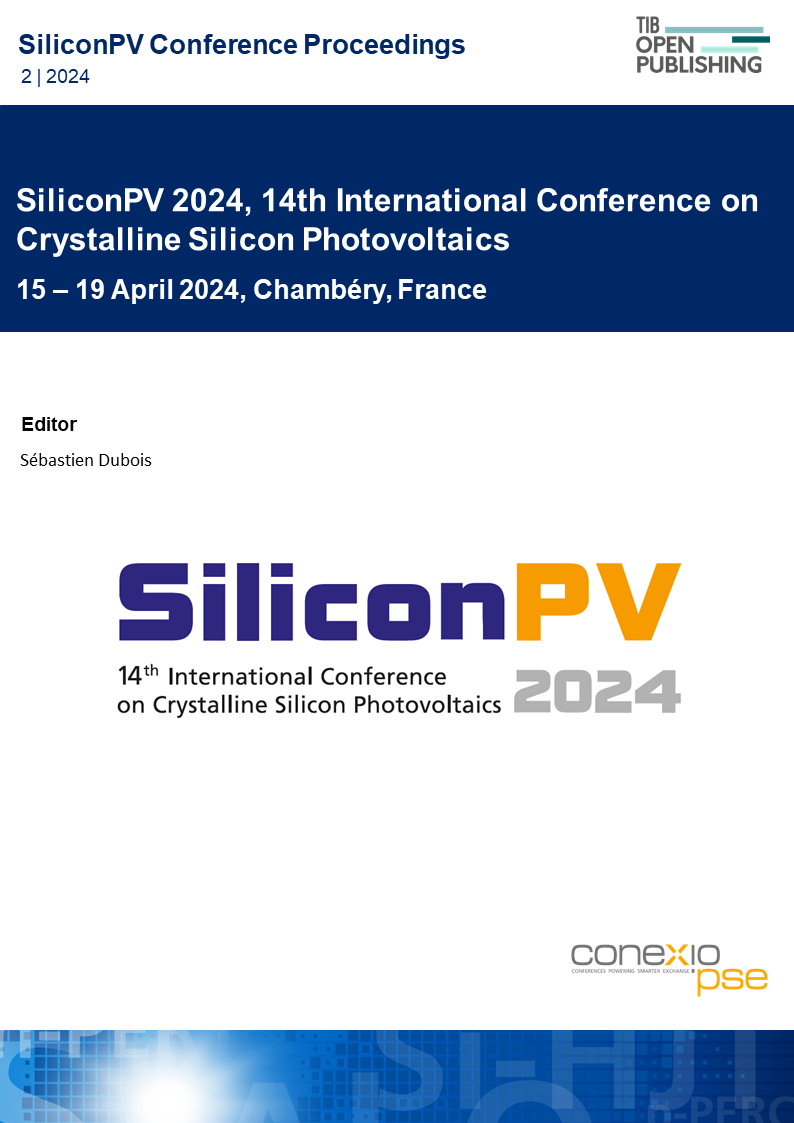Understanding and Minimizing Perimeter Losses of Silicon-Based Monolithic Tandem Solar Cells – A Simulation Study
DOI:
https://doi.org/10.52825/siliconpv.v2i.1326Keywords:
Tandem Solar Cell, Perimeter Loss, SimulationAbstract
The vast majority of monolithic perovskite-silicon-based tandem cells to date is manufactured in R&D environments using small scale perovskite top cells (~1-4 cm²), typically placed on a larger silicon bottom cell. The high perimeter-to-area ratio leads to significant perimeter losses, which limit the maximum achievable efficiency and complicates loss analysis for further design optimization. An understanding of perimeter loss mechanisms and design rules for their minimization is therefore important for effectively progressing high efficient tandem solar cells in R&D. In this work we perform a 3D device simulation study of perimeter losses in an exemplary perovskite-silicon tandem solar cell. The impact of structuring the various laterally conducting layers, i.e. at the front and rear side as well as between the sub cells, on the perimeter efficiency loss is systematically investigated. We thereby identify the fundamental mechanisms of carrier transport into the perimeter, and clarify the impact of the silicon and perovskite absorber, the various laterally conducting layers, as well the electrical connection of the sub cells. We find that in each sub cell at least one carrier type must be hindered to be conducted into the perimeter. This is however complicated by the fact that this parasitic lateral transport can also be provided by “bordering” conductive layers connected via the tunnelling or recombination junction. Promising structuring variants and general design rules to achieve low perimeter losses with low structuring effort are then derived from the results. The losses are quantified to range from ~0.2 – 4%abs for a 1 cm2 top cell size, with the lowest values representing an unavoidable loss from the Si wafer conductance which is present also in champion cells with high structuring effort.
Downloads
References
[1] E. Aydin et al., “Enhanced optoelectronic coupling for perovskite/silicon tandem solar cells,” (eng), Nature, vol. 623, no. 7988, pp. 732–738, 2023. https://doi.org/10.1038/s41586-023-06667-4.
[2] O. Er-raji et al., “Loss Analysis of Fully‐Textured Perovskite Silicon Tandem Solar Cells: Characterization Methods and Simulation toward the Practical Efficiency Potential,” (en), Solar RRL, vol. 7, no. 24, p. 2300659, 2023. https://doi.org/10.1002/solr.202300659.
[3] Y. Wu et al., “27.6% Perovskite/c‐Si Tandem Solar Cells Using Industrial Fabricated TOPCon Device,” Adv. Energy Mater., vol. 12, no. 27, 2022. https://doi.org/10.1002/aenm.202200821.
[4] K. R. McIntosh, “Lumps, humps and bumps: three detrimental effects in the current-voltage curve of silicon solar cells,” 2001.
[5] A. Fell et al., “Combining Drift-Diffusion and Equivalent-Circuit Models for Efficient 3D Tandem Solar Cell Simulations,” IEEE J. Photovoltaics, vol. 12, no. 6, pp. 1469–1476, 2022. https://doi.org/10.1109/JPHOTOV.2022.3209608.
[6] A. Fell et al., “Modeling Edge Recombination in Silicon Solar Cells,” IEEE J. Photovoltaics, vol. 8, no. 2, pp. 428–434, 2018. https://doi.org/10.1109/JPHOTOV.2017.2787020.
[7] P. P. Altermatt et al., “Numerical quantification and minimization of perimeter losses in high-efficiency silicon solar cells,” Progress in Photovoltaics: Research and Applications, vol. 4, no. 5, pp. 355–367, 1996. https://doi.org/10.1002/(sici)1099-159x(199609/10)4:5<355::aid-pip145>3.0.co;2-x.
[8] C. Blaga et al., “Palliating the efficiency loss due to shunting in perovskite/silicon tandem solar cells through modifying the resistive properties of the recombination junction,” Sustainable Energy Fuels, vol. 5, no. 7, pp. 2036–2045, 2021. https://doi.org/10.1039/D1SE00030F.
Published
How to Cite
Conference Proceedings Volume
Section
License
Copyright (c) 2024 Andreas Fell, Martin Bivour, Mario Hanser, Martin Schubert

This work is licensed under a Creative Commons Attribution 4.0 International License.
Accepted 2024-09-10
Published 2025-01-09
Funding data
-
Bundesministerium für Wirtschaft und Technologie
Grant numbers 03EE1132B;03EE1191
